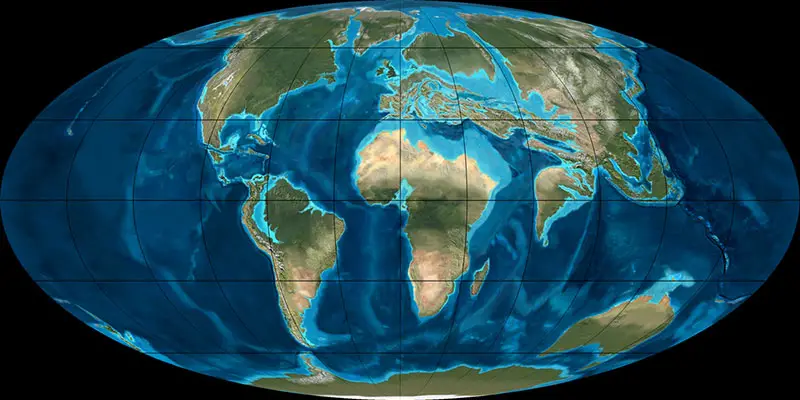†Sivaladapidae
Sivaladapidae ist der Familienname von 35 Primaten, die ab dem frühen Eozän vor 56 Millionen Jahren bis vor 33,9 Millionen Jahren lebten.
Nur sehr wenige Adapiformes oder Omomyiformes haben die Übergangszeit vom Eozän zum Oligozän überlebt. Die Mitglieder der Familie Sivaladapidae sind eine Ausnahme.
Sie sind hauptsächlich aus dem späten Miozän Süd- und Ostasiens bekannt, wo sie mit drei Gattungen vertreten waren. Am bekanntesten ist die Gattung Sivaladapis, von der man nur Gebisse fand [1], die durch vollständig molariforme vierte Prämolaren und einfache dreihöckrige obere Molaren mit gut entwickelten Mesostylen gekennzeichnet sind.
Hoanghonius wurde verschiedentlich zur Familie Omomyidae oder Adapidae gezählt und hat auch in Diskussionen über Herkunft der Anthropoidea (Eigentliche Affen) eine Rolle gespielt. Eine Zugehörigkeit zu den Adapiden scheint am wahrscheinlichsten, aber bis bessere Exemplare bekannt sind, bleiben die Verwandschaftsverhältnisse ungewiss.
| Die Welt zur Zeit von Sivaladapidae | |
|---|---|
 Landmassenverteilung im System Eozän
Landmassenverteilung im System Eozän Bild: Ron Blakely
|
|
| Ernährung/Lebensraum | |
| Geographie, Epoche | |
| Lebte im: |
System: Eozän |
| Verbreitung: | |
| Physiologie | |
|---|---|
| Gewicht: | ? |
| Schwestertaxa | |
Die Gattung Wailekia aus dem Eozän von Krabi, Thailand, wurde als primitiver Anthropoide beschrieben und ist möglicherweise mit Hoanghonius verwandt [2].
Literatur
O. Zdansky 1930, Die alttertiären Säugetiere Chinas nebst stratigraphischen Bemerkungen (Mammalian fauna of the Lower Tertiary from China and some stratigraphic remarks). Palaeontologia Sinica, Series C. 7:2, p. 1 - 87J.-K. Woo, M.-C. Chow 1957, New Materials of the Earliest Primate Known in China — Hoanghonius stehlini. Vertebrata PalAsiatica. 1:4, p. 267 - 272
M. Chow, Ch. Li, Y. Chang 1973, Late Eocene mammalian faunas of Honan and Shansi with notes on some vertebrate fossils collected therefrom. Vertebrata PalAsiatica (Gujizhui dongwu yu gurenlei). 11:2, p. 165 - 181
J. J. M. Moonen, P. Y. Sondaar, S. T. Hussain 1978, A comparison of larger fossil mammals in the stratotypes of the Chinji, Nagri and Dhok Pathan Formations (Punjab, Pakistan). Proceedings of the Koninklijke Nederlandse Akademie van\r\nWetenschappen, Series B: Palaeontology, Geology, Physics and Chemistry. 81:4, p. 425 - 436
R. Wu, Y. Pan, S. T. Hussain 1985, A new Adapid Primate from the Lufeng Miocene, Yunnan. Acta Anthropologica Sinica (Renleixue xuebao). 4:1, p. 1 - 6
Y. Pan, R. Wu, S. T. Hussain 1986, A new species of Sinoadapis from the Lufeng hominoid locality. Acta Anthropologica Sinica. 5:1, p. 31 - 49
Z. Qiu, R. Wu, S. T. Hussain 1990, The Chinese Neogene mammalian biochronology - its correlation with the European Neogene mammal zonation. In E.H. Lindsay, V. Fahlbusch and P. Mein, eds., European Neogene Mammal Chronology. Plenum Press, New York.. :1, p. 527 - 556
P. D. Gingerich, P. A. Holroyd, R. L. Ciochon 1994, Rencunius zhoui, New Primate from the Late Middle Eocene of Henan, China, and a Comparison with Some Early Anthropoidea. Anthropoid Origins, edited by J. G. Fleagle and R. F. Kay. Plenum Press, New York, 1994.. :1, p. 163 - 177
S. Ducrocq, J.-J. Jaeger, Y. Chaimanee, V. Suteethorn 1995, New primate from the Palaeogene of Thailand, and the biogeographical origin of anthropoids. Journal of Human Evolution. 28:1, p. 477 - 485
Y. Tong, J.-J. Jaeger, Y. Chaimanee, V. Suteethorn 1997, Middle Eocene Small Mammals from Liguanqiao Basin of Henan Province and Yuanqu Basin of Shanxi Province, Central China. Palaeontologica Sinica, New Series C. 26:1, p. 1 - 256
T. Qi, K. C. Beard, Y. Chaimanee, V. Suteethorn 1998, Late Eocene sivaladapid primate from Guangxi Zhuang Autonomous Region, People's Republic of China.. Journal of Human Evolution. 35:1, p. 211 - 220
L. Marivaux, J.-L. Welcomme, S. Ducrocq, J.-J. Jaeger 2002, Oligocene sivaladapid primate from the Bugti Hills (Balochistan, Pakistan) bridges the gap between Eocene and Miocene adapiform communities in southern Asia.. Journal of Human Evolution. 42:1, p. 379 - 388
K. C. Beard, L. Marivaux, S. T. Tun, A. N. Soe, Y. Chaimanee, W. Htoon, B. Marandat, H. H. Aung, J.-J. Jaeger 2007, New sivaladapid primates from the Eocene Pondaung Formation of Myanmar and the anthropoid status of Amphipithecidae. Bulletin of Carnegie Museum of Natural History. 39:1, p. 67 - 76
Y. Chaimanee, C. Yamee, P. Tian, O. Chavasseau, J.-J. Jaeger 2008, First middle Miocene sivaladapid primate from Thailand. Journal of Human Evolution. 54:3, p. 434 - 443
Y. Chaimanee, O. Chavasseau, V. Lazzari, A. Euriat, J.-J. Jaeger 2013, A new Late Eocene primate from the Krabi Basin (Thailand) and the diversity of Palaeogene anthropoids in southeast Asia. Proceedings of the Royal Society B. 280:3, p. 20132268 - 443, DOI: 10.1098/rspb.2013.2268
X. Ni, Q. Li, L. Li, K. C. Beard 2016, Oligocene primates from China reveal divergence between African and Asian primate evolution. Science. 352:6286, p. 673 - 677, DOI: 10.1098/rspb.2013.2268
C.C. Gilbert, B.A. Patel, N.P. Singh, C.J. Campisano, J.G. Fleagle, K.L. Rust, R. Patnaik 2017, New sivaladapid primate from Lower Siwalik deposits surrounding Ramnagar (Jammu and Kashmir State), India. Journal of Human Evolution. 102:6286, p. 21 - 41, DOI: 10.1098/rspb.2013.2268